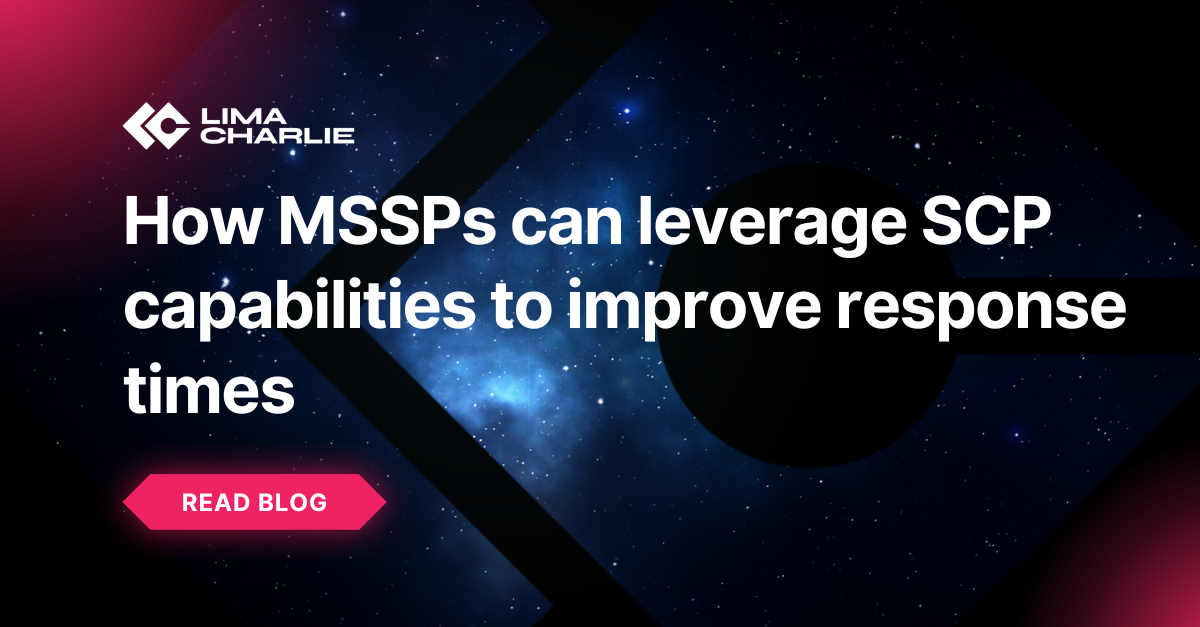How MSSPs can leverage SCP capabilities to improve response times

Sr. Technical Content Strategist

The SecOps Cloud Platform (SCP) helps managed security service providers (MSSPs) improve their response times in several ways. Here is an overview of the most significant use cases:
Powerful Endpoint Detection and Response Capabilities
The SecOps Cloud Platform offers a robust suite of endpoint detection and response (EDR) capabilities. MSSPs often find that they can use these capabilities to achieve results comparable to industry-leading EDR solutions—but at a fraction of the cost and without the vendor lock-in that such tools typically entail.
The SCP’s multi-platform agent provides feature parity across Windows, Linux, and macOS operating systems and offers browser-based versions to help secure ChromeOS and Edge. The agent enables telemetry to be streamed into the LimaCharlie cloud from any source and run through a detection and response engine. MSSPs can write their own custom detection and response (D&R) logic or leverage curated rulesets like Sigma, Soteria, and YARA. They can also define automated responses based on telemetry data, enabling response actions on endpoints in as little as 100ms.
Notably, the SCP recently introduced a bidirectional messaging capability to allow security teams to define automated response actions across third-party tools as well, further simplifying and speeding D&R workflows.
As one MSSP founder put it:
Our previous technology was at the cutting edge of open-source capabilities—but our mean time to detect (MTTD) and mean time to respond (MTTR) were still measured in minutes. The LimaCharlie SCP agent has improved our MTTD and MTTR by around 98%. That’s massive. We’ve gotten our response times down from minutes to milliseconds.
Faster Deployment During Incident Response Engagements
MSSPs face several speed bumps during incident response (IR) engagements: Obtaining initial access to the client environment, a lack of historical data to use in establishing an incident timeline, and the need to deal with vendor gatekeepers when deploying core tools.
The SecOps Cloud Platform helps to solve all of these problems, and can thus significantly speed response and remediation.
First, the SCP’s multiplatform agent—complete with powerful EDR and data-routing capabilities—can be deployed at scale into client environments in a matter of minutes. This gives IR teams a nearly immediate presence on endpoints.
In addition, the SCP enables easy integration with open-source digital forensics tools like Velociraptor, Hayabusa, and Plaso. This makes it possible for incident responders to build a rich timeline using historical telemetry data—and to automate the processing of forensic artifacts.
Lastly, because the SCP is available via an on-demand public cloud-like delivery model, there is never any need to talk to a salesperson or negotiate a contract before using the platform for incident response. Teams can deploy what they need, when they need it, and will only pay for what they use.
For a more in-depth look at how the SCP can speed IR engagements, including an infrastructure as code (IaC) template to use in your own work, read:
Automating Incident Response Workflows with LimaCharlie
Rapid Response Capabilities with Sleeper Mode
MSSPs can also improve response times by leveraging the SCP’s unique pricing model and extensive customizability to pre-deploy sensors to client endpoints at near zero cost.
Similar to an IT public cloud provider such as AWS, the SCP’s pricing model is pay-per-use. In combination with the platform’s unparalleled degree of control, this lets MSSPs deploy sensors into client environments in a sort of “sleeper mode.”
Sleeper mode means that SCP sensors are present on endpoints—but with their settings turned down low to minimize resource consumption and costs. For pennies per month, sensors can be placed on critical endpoints or even deployed fleetwide, ready and waiting.
If an incident occurs, those sensors can be activated, giving responders access to full-fledged EDR and containment capabilities in just minutes.
From a security operations perspective, sleeper mode helps teams take a more proactive approach to IR and respond to critical events far more quickly than would otherwise be possible. And in terms of the business of cybersecurity, sleeper mode allows MSSPs to offer clients extremely competitive service-level agreements.
For more on how to implement this use case, read the Sleeper Deployment documentation.
Learning more
The SecOps Cloud Platform helps MSSPs to improve their response times—but that’s just one small part of what the platform can offer to managed security service providers.
To learn more about how the SCP can enable MSSPs to deliver better security outcomes and compete more effectively, see the panel discussion: The SecOps Cloud Platform for Managed Security Service Providers.
To experience the SCP for yourself, book a demo with our team.